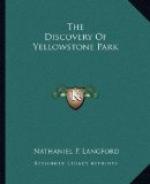INTRODUCTION
When the rumored discovery in the year 1861 of extensive gold placers on Salmon river was confirmed, the intelligence spread through the states like wild fire. Hundreds of men with dependent families, who had been thrown out of employment by the depressed industrial condition of the country and by the Civil War, and still others actuated by a thirst for gain, utilized their available resources in providing means for an immediate migration to the land of promise. Before midsummer they had started on the long and perilous journey. How little did they know of its exposures! The deserts, destitute of water and grass, the alkaline plains where food and drink were alike affected by the poisonous dust, the roving bands of hostile Indians, the treacherous quicksands of river fords, the danger and difficulty of the mountain passes, the death of their companions, their cattle and their horses, breakage of their vehicles, angry and often violent personal altercations—all these fled in the light of the summer sun, the vernal beauty of the plains and the delightfully pure atmosphere which wooed them day by day farther away from the abode of civilization and the protection of law. The most fortunate of this army of adventurers suffered from some of these fruitful causes of disaster. So certain were they to occur in some form that a successful completion of the journey was simply an escape from death. The story of the Indian murders and cruelties alone, which befell hundreds of these hapless emigrants, would fill volumes. Every mile of the several routes across the continent was marked by the decaying carcasses of oxen and horses, which had perished during the period of this hegira to the gold mines. Three months with mules and four with oxen were necessary to make the journey—a journey now completed in five days from ocean to ocean by the railroad. Some of these expeditions, after entering the unexplored region which afterwards became Montana, were arrested by the information that it would be impossible to cross with wagon teams the several mountain ranges between them and the mines.
In the summer of 1862 a company of 130 persons left St. Paul for the Salmon river mines. This Northern overland expedition was confided to the leadership of Captain James L. Fisk, whose previous frontier experience and unquestionable personal courage admirably fitted him for the command of an expedition which owed so much of its final success, as well as its safety during a hazardous journey through a region occupied by hostile Indians, to the vigilance and discipline of its commanding officer. E.H. Burritt was first assistant, the writer was second assistant and commissary, and Samuel R. Bond was secretary. Among those who were selected for guard duty were David E. Folsom, Patrick Doherty (Baptiste), Robert C. Knox, Patrick Bray, Cornelius Bray, Ard Godfrey, and many other well known pioneers of Montana. We started with ox teams on this journey on the 16th day of June, traveling by the way of Fort Abercrombie, old Fort Union, Milk river and Fort Benton, bridging all the streams not fordable on the entire route. Fort Union and Fort Benton were not United States military forts, but were the old trading posts of the American Fur Company.




